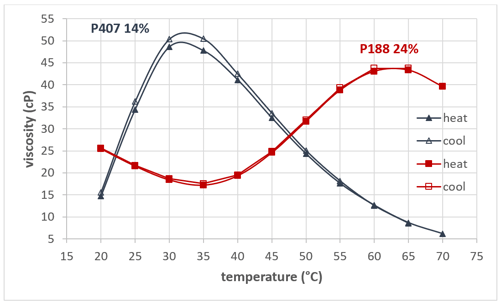Rheology modifiers are common additives used to adjust both the overall viscosity magnitude of solutions and control non-Newtonian behaviors such as shear thinning or shear thickening. These vital additives are able to achieve desired viscosity, and can also help in controlling shelf stability, ease of application, texture, and processability. There are hundreds of rheology modifiers on the market today and we have previously discussed four common modifiers: arginine, K-carrageenan, Xanthan Gum, and laponite.
Another common rheology modifier is poloxamers. Poloxamers are triblock copolymers composed of propylene oxide in the center block and ethylene oxide in the end blocks. Because propylene oxide is more hydrophobic than ethylene oxide, poloxamers are amphiphilic substances, meaning they possess both hydrophilic and lipophilic properties. This dual nature (i.e. both hydrophilic and hydrophobic blocks) can lead to self-assembly into structures such as spherical micelles. The specific microstructure will depend on the type of poloxamer, concentration, and temperature. Numerous Poloxamers, also known by trade names such as Pluronics and Lutrol, are available with various block ratios and total molecular weights to support a variety of applications.

This class of polymers can be used for thermo-responsive viscosity enhancement. For example, specific poloxamers have been designed to maintain a low viscosity near room temperature, but increase or even gel near body or skin temperature. This can be beneficial for topical applications or injectables formulated for controlled release. Different types of poloxamers can also be mixed together to tailor the level of viscosity modification and the transition temperature.
Since hydrophobic formulation components can be sequestered in the micellar core, another common application is to enhance solubility of moderately hydrophobic active s. Certain types of poloxamers have also been shown to reduce aggregation after denaturation when included in protein solutions below the critical micellar concentration (CMC) so that individual molecules can associate with hydrophobic domains exposed after unfolding.
Download our new application note "Viscosity Control with Thermo-responsive Polymers" to learn more about how viscosity as a function of poloxamer type, concentration, and temperature can be used as a key performance parameter. And, how the VROC® initium automated viscometer facilitates the thorough characterization of these complex fluids.

Written by: Stacey Elliott, PhD, RheoSense Principal Scientist


COMMENTS